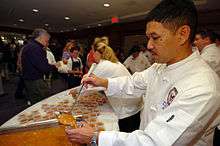Navy bean
| Navy Bean | |
|---|---|
| Species | Phaseolus vulgaris |
 | |
| Nutritional value per 100 g (3.5 oz) | |
|---|---|
| Energy | 1,468 kJ (351 kcal) |
|
60.75 g | |
| Sugars | 3.88 g |
| Dietary fiber | 24.4 g |
|
1.5 g | |
|
22.33 g | |
| |
|
†Percentages are roughly approximated using US recommendations for adults. Source: USDA Nutrient Database | |
The navy bean, haricot, pearl haricot bean,[1] boston bean,[2] white pea bean,[3] or pea bean,[4] is a variety of the common bean (Phaseolus vulgaris) native to the Americas, where it was domesticated.[5] It is a small, dry white bean which is smaller than many other types of white beans, and has an oval, slightly flattened shape.[1] It features in such dishes as baked beans,[1] and even pies, as well as in various soups such as Senate bean soup.[6]
The green bean plants[2] that produce navy beans may be either of the bush type or vining type, depending on which cultivar they are.[7]
Other white beans include cannellini, 'Great Northern', the lima beans known as "butter beans", and the runner bean.
History

The name "Navy bean" is an American term coined because the US Navy has served the beans as a staple to its sailors since the mid-1800s.[8]
In Australia, navy bean production began during World War II when it became necessary to find an economical way of supplying a nutritious food to the many troops - especially American troops - based in Queensland. The United States military maintained a large base in Kingaroy and had many bases and camps throughout south-east Queensland. It actively encouraged the widespread planting of the beans.[9] Kingaroy is known as the Baked Bean Capital of Australia.[10] Another popular name for the bean during this time was "the Yankee bean".[11]
Cultivars
Navy bean cultivars include:
Other white beans
Other white beans include:
- Cannellini (or fazolia,[2]), a white kidney bean, a variety popular in central and southern Italy, but first developed in Argentina.[2] They are larger than navy beans, closely related to the red kidney bean and, like the kidney bean, have higher levels of the toxic lectin phytohaemagglutinin. They are used in minestrone soups.[2]
- 'Great northern', also called "large white" beans, are also larger than navy beans, but smaller than cannellini beans, with a flattened shape similar to lima beans. They have a delicate flavour.
- The large white beans known in Greece as gígantes (Greek: γίγαντες, giants) and eléfantes (ελέφαντες, elephants) are from the runner bean, Phaseolus coccineus.
Nutritional value
White beans are the most abundant plant-based source of phosphatidylserine (PS) yet known.[14] It contains notably high levels of apigenin, 452±192 μg/kg, which vary widely among legumes.[15]
Consumption of baked beans has been shown to lower total cholesterol levels and low-density lipoprotein cholesterol.[16][17] This might be at least partly explained by high saponin content of navy bean. Saponins also exhibit antibacterial and anti-fungal activity, and have been found to inhibit cancer cell growth.[18] Furthermore, navy bean is the richest source of ferulic acid and p-coumaric acid among the common bean varieties.[19]
Storage and safety
Dried and canned beans stay fresh longer by storing them in a pantry or other cool, dark place under 75 °F (24 °C). With normal seed storage, seeds should last from one to four years for replanting, with a very large timetable for cooking for well-kept seeds, nearing on indefinite. Avoid beans which are discolored from the pure white color of these beans, as they may have been poorly handled while they dried.[20]
References
- 1 2 3 "Beans, White Pearl Haricot, Dried, per kilo". kirkfood.com.au. Retrieved 12 February 2017.
- 1 2 3 4 5 Willan, Anne (1989-09-17). La Varenne Pratique: Part 3, Vegetables, Pasta & Grains. p. 205. ISBN 9780991134625.
- ↑ "Bean (Phaseolus vulgaris)". Pulse Canada. Retrieved 30 August 2014.
- ↑ "Pea bean". The American Heritage Dictionary. Retrieved 2013-09-17.
- ↑ Paul Gepts (December 1998). "Origin and evolution of common bean: past events and recent trends". HortScience. 33 (7): 1124–1130.
- ↑ [senate.gov/reference/reference_item/bean_soup.htm Senate Bean Soup]
- ↑ Mark Goodwin (2003). "Crop Profile for Dry Beans" (PDF). Pulse Canada. Retrieved 30 August 2014.
- ↑ "History". Bean Growers Australia. Retrieved 2017-10-06.
- ↑ "History". Bean Growers Australia. Retrieved 2017-10-06.
- ↑ "History". Bean Growers Australia. Retrieved 2017-10-06.
- ↑ "History". Bean Growers Australia. Retrieved 2017-10-06.
- 1 2 3 4 James D. Kelly. "One Hundred Years of Bean Breeding at Michigan State University: A Chronology" (PDF). Retrieved 30 August 2014.
- ↑ Schwartz, H.F.; Corrales, M.A.P. (1989). Bean Production Problems in the Tropics. Centro Internacional de Agricultura Tropical (CIAT). ISBN 9789589183045.
- ↑ Souci SW, Fachmann E, Kraut H (2008). Food Composition and Nutrition Tables. Medpharm Scientific Publishers Stuttgart.
- ↑ Konar, Nevzat (2013). "Non-isoflavone phytoestrogenic compound contents of various legumes". European Food Research and Technology. 236 (3): 523–530. doi:10.1007/s00217-013-1914-0.
- ↑ Shutler, Susan M.; Bircher, Gemma M.; Tredger, Jacki A.; Morgan, Linda M.; Walker, Ann F.; Low, A. G. (2007). "The effect of daily baked bean (Phaseolus vulgaris) consumption on the plasma lipid levels of young, normo-cholesterolaemic men". British Journal of Nutrition. 61 (2): 257. doi:10.1079/BJN19890114.
- ↑ Winham, Donna M.; Hutchins, Andrea M. (2007). "Baked bean consumption reduces serum cholesterol in hypercholesterolemic adults". Nutrition Research. 27 (7): 380–386. doi:10.1016/j.nutres.2007.04.017.
- ↑ Shi, John; Xue, Sophia Jun; Ma, Ying; Li, Dong; Kakuda, Yukio; Lan, Yubin (2009). "Kinetic study of saponins B stability in navy beans under different processing conditions". Journal of Food Engineering. 93: 59–65. doi:10.1016/j.jfoodeng.2008.12.035.
- ↑ Luthria, Devanand L.; Pastor-Corrales, Marcial A. (2006). "Phenolic acids content of fifteen dry edible bean (Phaseolus vulgaris L.) varieties". Journal of Food Composition and Analysis. 19 (2–3): 205–211. doi:10.1016/j.jfca.2005.09.003.
- ↑ "How Long Do Beans Last?". Retrieved 23 November 2014.